Related Research Articles
A top-level domain (TLD) is one of the domains at the highest level in the hierarchical Domain Name System of the Internet after the root domain. The top-level domain names are installed in the root zone of the name space. For all domains in lower levels, it is the last part of the domain name, that is, the last non empty label of a fully qualified domain name. For example, in the domain name www.example.com, the top-level domain is com. Responsibility for management of most top-level domains is delegated to specific organizations by the ICANN, an Internet multi-stakeholder community, which operates the Internet Assigned Numbers Authority (IANA), and is in charge of maintaining the DNS root zone.
A domain name is a string that identifies a realm of administrative autonomy, authority or control within the Internet. Domain names are used in various networking contexts and for application-specific naming and addressing purposes. In general, a domain name identifies a network domain or an Internet Protocol (IP) resource, such as a personal computer used to access the Internet, or a server computer. Domain names are often used to identify services provided through the Internet, such as websites and email services. As of 2017, 330.6 million domain names had been registered.
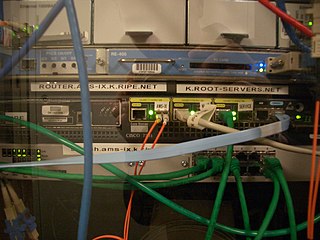
A root name server is a name server for the root zone of the Domain Name System (DNS) of the Internet. It directly answers requests for records in the root zone and answers other requests by returning a list of the authoritative name servers for the appropriate top-level domain (TLD). The root name servers are a critical part of the Internet infrastructure because they are the first step in resolving human-readable host names into IP addresses that are used in communication between Internet hosts.
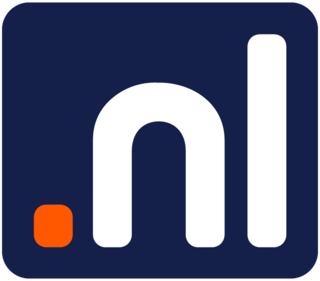
.nl is the Internet country code top-level domain (ccTLD) for the Netherlands. It is one of the most popular ccTLDs with over six million registered .nl domains as of 29 September 2020.
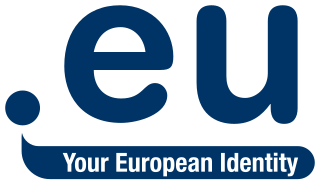
.eu is the country code top-level domain (ccTLD) for the European Union (EU). Launched on 7 December 2005, the domain is available for any person, company or organization based in the European Union. This was extended to the European Economic Area in 2014, after the regulation was incorporated into the EEA Agreement, and hence is also available for any person, company or organization based in Iceland, Liechtenstein and Norway. The TLD is administered by EURid, a consortium originally consisting of the national ccTLD registry operators of Belgium, Sweden, and Italy, joined later by the national registry operator of the Czech Republic. Trademark owners were able to submit registrations through a sunrise period, in an effort to prevent cybersquatting. Full registration started on 7 April 2006.
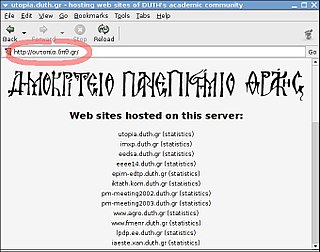
An internationalized domain name (IDN) is an Internet domain name that contains at least one label displayed in software applications, in whole or in part, in non-latin script or alphabet, such as Arabic, Bengali, Chinese, Cyrillic, Devanagari, Greek, Hebrew, Hindi, Tamil or Thai or in the Latin alphabet-based characters with diacritics or ligatures, such as French, German, Italian, Polish, Portuguese or Spanish. These writing systems are encoded by computers in multibyte Unicode. Internationalized domain names are stored in the Domain Name System (DNS) as ASCII strings using Punycode transcription.

.us is the Internet country code top-level domain (ccTLD) for the United States. It was established in early 1985. Registrants of .us domains must be U.S. citizens, residents, or organizations, or a foreign entity with a presence in the United States. Most registrants in the U.S. have registered for .com, .net, .org and other gTLDs, instead of .us, which has primarily been used by state and local governments, even though private entities may also register .us domains.

.uk is the Internet country code top-level domain (ccTLD) for the United Kingdom. It was first registered in July 1985, seven months after the original generic top-level domains such as .com and the first country code after .us.
A country code top-level domain (ccTLD) is an Internet top-level domain generally used or reserved for a country, sovereign state, or dependent territory identified with a country code. All ASCII ccTLD identifiers are two letters long, and all two-letter top-level domains are ccTLDs.
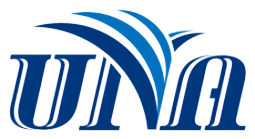
.an was the Internet country code top-level domain (ccTLD) for the former Netherlands Antilles. It was administered by the University of the Netherlands Antilles. The domain was phased out after the Netherlands Antilles were dissolved in 2010. As of November 2010 the .an domain remained live with over 800 domains registered under .an, including secondary levels. On 31 July 2015, use of the domain was discontinued.
Western Sahara is a disputed territory, and as such it has no country code top-level domain (ccTLD). .eh is reserved for this purpose, and will be assigned if the Western Sahara conflict results in an agreement between Spain and Morocco. IANA has not designated a ccTLD manager for the .eh domain.
.yu was the Internet country code top-level domain (ccTLD) that was assigned to SFR Yugoslavia in 1989 and was mainly used by the Federal Republic of Yugoslavia and its successor states after 1994. After Serbia and Montenegro acquired separate .rs and .me domains in 2007, a transition period started, and the .yu domain finally expired in 2010.
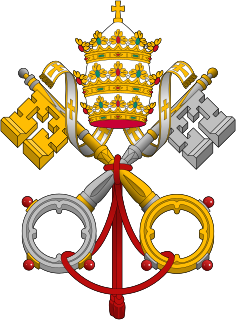
.va is the Internet country code top-level domain (ccTLD) for the Vatican City State. It is administered by the Vatican Internet Service.
A sponsored top-level domain (sTLD) is one of the categories of top-level domains (TLDs) maintained by the Internet Assigned Numbers Authority (IANA) for use in the Domain Name System of the Internet, alongside country-code top-level domains (ccTLD) and generic top-level domains (gTLD).

.uz is the Internet country code top-level domain (ccTLD) for Uzbekistan. Registry services were formerly operated by Euracom GmBH, but were later redelegated to UZINFOCOM. Registrations are taken directly at the second level, but the former registry also advertised the availability of registrations at the third level beneath co.uz and com.uz, and some domain names under other second-level names such as org.uz also exist.

.in is the Internet country code top-level domain (ccTLD) for India. It was made available in 1989, four years after original generic top-level domains such as .com, .net and the country code like .us. It is currently administered by the National Internet Exchange of India (NIXI).

.tr is the Internet country code top-level domain (ccTLD) for Turkey. It is administered by NIC.TR Computer Center and Turkey Internet Society. .nc.tr and .ct.tr are used as second-level domains for the Turkish Republic of Northern Cyprus, which is a self declared state and not recognised by the United Nations, and as such has no country code assigned.
.gp is the country code top-level domain (ccTLD) for Guadeloupe. Pricing differs for Guadeloupians compared to other Internet users.

.so is the internet country code top-level domain (ccTLD) for Somalia. After a long absence, the .so domain was officially relaunched on November 1, 2010, by .SO Registry, which is regulated by the nation's Ministry of Posts and Telecommunications. It was launched through various accredited registrars around the world.
The domain name .укр is an approved internationalized country code top-level domain for Ukraine. It is a common abbreviation used in Ukraine, as in Ukrbank and Ukrnafta.
References
- ↑ "Всі сайти Еритреї - доменної зони .er". 101database.com (in Ukrainian). Archived from the original on 2021-08-31. Retrieved 2021-08-31.
- ↑ "ER Zone File". Robert Baskerville's ccTLD analysis data. 2007-12-28. Archived from the original on 2008-01-19. Retrieved 2007-12-28.